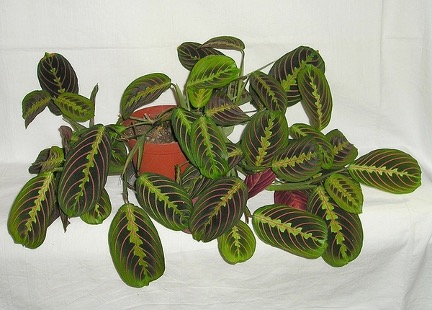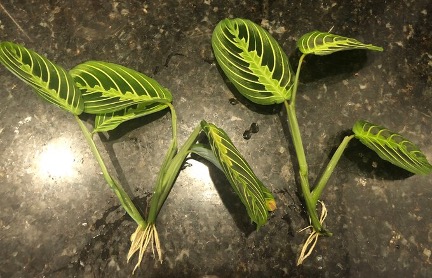The lemon lime prayer plant rarely flowers indoors, but most grow it for its beautiful foliage. Red veins that resemble fish bones flow across the surface. The leaf center and underside are pale green and the rest is often dark green, hence the name “Maranta tricolor”.

This plant suffers under drought or intense sun, and loves lots of moisture! Follow along for more plant tips.
History & Background
This species is called Maranta leuconeura. Other species in the genus Maranta are also called prayer plant based on their leaves, which turn upward at night.
Prayer plants are found in the tropical forests of South America, but this species’ natural range lies within Brazil. The plant creeps along the ground, sending up shoots that bear evergreen leaves 4 – 8 inches long.
| Scientific Name | Maranta Leuconeura |
|---|---|
| Common Names | Maranta fascinator, Herringbone plant, Maranta tricolor |
| Max Height | 1 foot |
| Max Spread | 3 feet |
| Growth Habit | Clump-forming perennial |
| Water Needs | Consistently moist |
| Light Level | Bright light, no direct sun |
| Hardiness | USDA zones 11-12 |
| Humidity Level | Above 40% |
| Soil Type | Well-drained with organic matter |
| Native Range | Brazilian tropical rainforests |
| Propagation | Rhizome division or stem cuttings |
| pH Level | Slightly acidic (5.5 – 6.0) |
Lighting
The prayer plant naturally grows where tree canopies keep out most direct sunlight. Too much exposure can actually cause the vibrant leaf colors to fade. Burned leaf edges can also be a sign of too much sun.
Maranta leuconeura can grow in full to partial shade outdoors. If you are growing this plant indoors, placing it in a corner near a window will give it enough light.
Watering
In the tropical rainforest, the soil is consistently moist and the air is thick with humidity. Avoid exposing this plant to drought conditions by never letting the soil completely dry. The leaf edges will curl and dry if this happens.
In fact, the soil needs consistent moisture throughout the year. You can gauge this using your fingers. Water when the top 1-2 inch layer of soil feels dry.
However, browning leaf tips can also result from your water source. Tap water has varying levels of fluoride, calcium, and other minerals than can burn the plants and cause leaf yellowing. Avoid this problem by using distilled or rain water.
Soil
On the forest floor, animals, living things decompose and form a soil layer known as humus. It is rich in organic matter and the prayer plant thrives in it.
Because of this, soil-based potting mixes that drain well are an ideal choice. There are also soil mixes specifically for tropical plants.
Soil without proper drainage may cause root rot or plant collapse. You can prevent this issue by amending your soil with pumice, perlite or sand.
Fertilizer
This plant likes to be fed throughout the year, though the timing changes with the seasons.
During the growing season, apply liquid fertilizer monthly or biweekly. Nutrients are not as vital in the winter, but can be given no more than once a month.
Leaves can be burned from excess nutrients or salts, and under this routine the prayer plant is getting a lot of it. So whatever the recommended dose is, give it at half strength.
Temperature
This plant is purely tropical and does not tolerate any frost. It prefers temperatures above 60°F, making it great for most indoor places. Prolonged exposure below this level can cause leaf drop.
The ideal thermal range for this plant is 65 – 80°F and does not flourish in temperatures well outside this range. This greatly limits the areas that are suitable for year-round growing.
The prayer plant can be grown in shaded locations in USDA hardiness zones 11-12. Reference this global hardiness map to see where it can be grown:

Humidity
The lemon lime prayer plant needs at least 40% humidity to flourish, but can benefit further from levels above 60%.
A word of caution, though: Harmful fungi produce spores in these conditions, so watch for signs of infection, such as powdery mildew and leaf rust.
What is the best indoor location for the Maranta Lemon Lime plant? Places with naturally high humidity, such as kitchens or bathrooms.
There are several other tricks for raising humidity levels:
- Routinely mist the leaves
- Avoid placing near drafty areas
- Place it near other plants
- Boil water or use a humidifier
- Thoroughly watering the plant
Propagating
You can either produce more prayer plants by root division or stem cuttings, though root division is more common.
For stem cuttings, take a section that has at least 3 nodes and cut ½ inch below the node. Afterwards, place it in a glass of water out of direct sunlight.
Change the water every 2 days and watch for root growth at the nodes. Make sure none of the leaves are submerged.
Once new leaves form and the roots are 1 inch long, the cutting is ready to transplant. Prayer plants can grow in shallow soil, so you have the option of planting into trays.

This plant is rhizomatous, meaning it sends up new shoots from stems that run underneath the soil. This growth habit allows us to divide plants into smaller clumps and repot them. Divide your plants into no more than 3 sections and separate the roots.
Repotting and Potting
Your plant will eventually become root bound in its container and needs rehomed about once every 2 years. Other signs include roots wrapping around the pot or jutting above the soil.
Whether you are repotting a whole plant or dividing one into sections, aim for your new container to be 1-2 inches larger than the root ball.
Here’s how to repot your prayer plant:
- Lay the pot on its side and arrange the stems away from it
- Gently hold the base of the plant and slowly remove the pot
- Brush the soil off the roots
- Place the root ball in the new pot and fill with soil
- Lightly press the soil and water deeply
Pests and Diseases
When you bring this plant into your home, keep it isolated from others for at least 2 weeks. Houseplants can be infected before even bringing them home.
This quarantine period allows you to check your prayer plant for pests and diseases while reducing their spread. Mealy bugs, thrips and spider mites feed on the sap of this plant.
All of these creatures can be rinsed off of the plant, but large outbreaks may require using insecticidal soaps, or the removal of infected parts.
Thrips are a bit trickier because they lay eggs inside the leaves instead of on the surface. Damaged leaves have silvery streaks across the surface.
Using blue sticky traps can be used to catch thrips. You may also use a systemic insecticide that is absorbed through the roots.
Cucumber mosaic virus causes mottled and malformed leaves. Disinfect your tools, keep aphids away and remove any infected plants. This disease has no cure, so prevention is key.
Toxicity
Are Maranta plants pet friendly? According to the ASPCA, they are non-toxic to cats, dogs and humans.
Conclusion
The lemon lime prayer plant loves consistent moisture and nutrients, and does not mind low lighting. Cuttings or root divisions can be used to multiply your supply.
Its temperature needs are a bit stricter and should not drop anywhere near freezing. Pests can plague this plant, but most problems can be avoided with well-draining soil and proper watering.
Création de compte Binance
Monday 25th of August 2025
Can you be more specific about the content of your article? After reading it, I still have some doubts. Hope you can help me. https://www.binance.info/bg/register?ref=V2H9AFPY
binance referal code
Friday 22nd of August 2025
Your article helped me a lot, is there any more related content? Thanks!
打开Binance账户
Friday 22nd of August 2025
Can you be more specific about the content of your article? After reading it, I still have some doubts. Hope you can help me.
binance us register
Wednesday 20th of August 2025
Your point of view caught my eye and was very interesting. Thanks. I have a question for you.
binance
Tuesday 19th of August 2025
Thanks for sharing. I read many of your blog posts, cool, your blog is very good. https://www.binance.com/en-IN/register?ref=UM6SMJM3